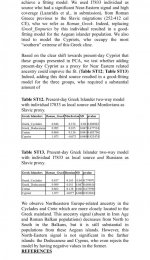Ralphie Boy
Regular Member
- Messages
- 249
- Reaction score
- 116
- Points
- 43
- Y-DNA haplogroup
- I2a-Y18331-Y66192
I see we have our first sample from pre-Slavic Roman Greece (sorry if someone already mentioned it and I missed it). This sample is used to model Greek islanders and has a lot of “Near Eastern” ancestry, but I don’t think is in the PC maps. This sample should plot with modern Dodecanese and Cyprus in this study. If this is what many Greeks were like just before the Slavs it would reinforce what some previously thought and seemed like common sense, that they would plot with Aegean islanders.




